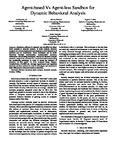Agent-based Vs Agent-less Sandbox for Dynamic Behavioral Analysis
| dc.contributor.author | Ali, M | |
| dc.contributor.author | Shiaeles, S | |
| dc.contributor.author | Papadaki, M | |
| dc.contributor.author | Ghita, BV | |
| dc.date.accessioned | 2019-07-28T01:06:43Z | |
| dc.date.available | 2019-07-28T01:06:43Z | |
| dc.date.issued | 2018-10 | |
| dc.identifier.isbn | 9781538672723 | |
| dc.identifier.issn | 2150-329X | |
| dc.identifier.uri | http://hdl.handle.net/10026.1/14703 | |
| dc.description | 2018 Global Information Infrastructure and Networking Symposium (GIIS) | |
| dc.description.abstract |
Malicious software is detected and classified by either static analysis or dynamic analysis. In static analysis, malware samples are reverse engineered and analyzed so that signatures of malware can be constructed. These techniques can be easily thwarted through polymorphic, metamorphic malware, obfuscation and packing techniques, whereas in dynamic analysis malware samples are executed in a controlled environment using the sandboxing technique, in order to model the behavior of malware. In this paper, we have analyzed Petya, Spyeye, VolatileCedar, PAFISH etc. through Agent-based and Agentless dynamic sandbox systems in order to investigate and benchmark their efficiency in advanced malware detection. | |
| dc.format.extent | 1-5 | |
| dc.language.iso | en | |
| dc.publisher | IEEE | |
| dc.subject | Malware detection | |
| dc.subject | Static analysis | |
| dc.subject | Dynamic analysis | |
| dc.subject | Cuckoo | |
| dc.subject | VMRay | |
| dc.title | Agent-based Vs Agent-less Sandbox for Dynamic Behavioral Analysis | |
| dc.type | conference | |
| dc.type | Proceedings Paper | |
| plymouth.author-url | http://arxiv.org/abs/1904.02100v1 | |
| plymouth.date-start | 2018-10-23 | |
| plymouth.date-finish | 2018-10-25 | |
| plymouth.volume | 00 | |
| plymouth.publisher-url | http://dx.doi.org/10.1109/GIIS.2018.8635598 | |
| plymouth.conference-name | 2018 Global Information Infrastructure and Networking Symposium (GIIS) | |
| plymouth.publication-status | Published | |
| plymouth.journal | 2018 Global Information Infrastructure and Networking Symposium (GIIS) | |
| dc.identifier.doi | 10.1109/giis.2018.8635598 | |
| plymouth.organisational-group | /Plymouth | |
| plymouth.organisational-group | /Plymouth/Faculty of Science and Engineering | |
| plymouth.organisational-group | /Plymouth/Faculty of Science and Engineering/School of Engineering, Computing and Mathematics | |
| plymouth.organisational-group | /Plymouth/REF 2021 Researchers by UoA | |
| plymouth.organisational-group | /Plymouth/REF 2021 Researchers by UoA/UoA11 Computer Science and Informatics | |
| plymouth.organisational-group | /Plymouth/Users by role | |
| plymouth.organisational-group | /Plymouth/Users by role/Academics | |
| dcterms.dateAccepted | 2018-01-01 | |
| dc.rights.embargodate | 2024-1-4 | |
| rioxxterms.versionofrecord | 10.1109/giis.2018.8635598 | |
| rioxxterms.licenseref.uri | http://www.rioxx.net/licenses/all-rights-reserved | |
| rioxxterms.type | Conference Paper/Proceeding/Abstract |


